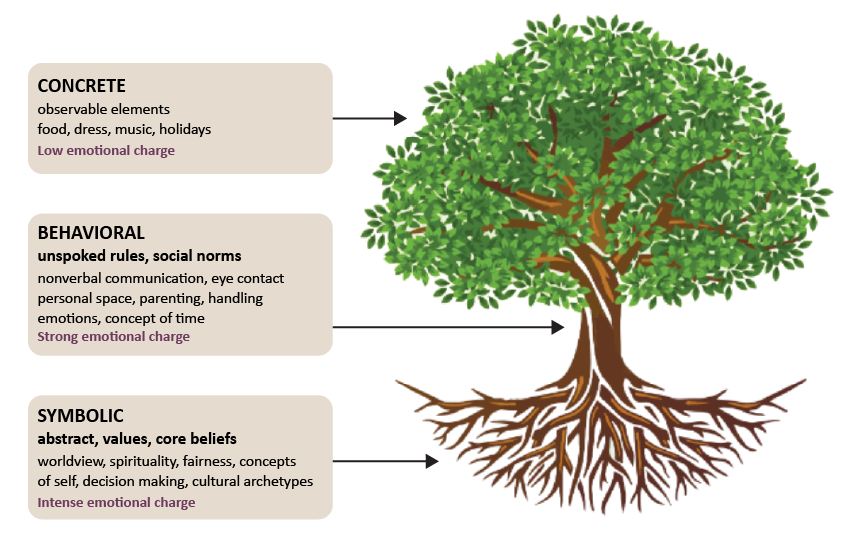You are here
Challenge 1: Culture Informs Bias
Culture Informs Bias
When thinking about culture and upbringing, the question is not if culture has impacted your beliefs about the groups of people represented by the students and families in your school(s), but to what extent. Zaretta Hammond’s culture tree below can help us understand this.
At the roots of the tree, we find our beliefs, values, worldview and how we see ourselves. These were all learned from people we know and love, such as our relatives, friends, teachers and spiritual leaders, as well as our own personal lived experiences – even from movies and television shows.
The tree trunk reflects how we behave as a result of these symbols.
And the very top of the tree are the leaves. And while they can seem small and somewhat inconsequential, they hold great insight into what gets celebrated, acknowledged and/or expressed (Hammond, 2015).
Base of the tree
-
How do I see myself?
-
How do I see historically marginalized communities? What informed that perspective? Entertainment? Media? Other?
-
What is my worldview about how people move up in this world and who has the best chances of doing that?
-
Do I see some people as deserving and others as undeserving?
-
Do I see some people as more valuable/important than others?
-
What is my philosophy about school and how schools should look, operate, function? What about the educational system?
Tree trunk
-
Who are the types of students/families I get along with? How do they act?
-
Who are the type of students/families I hold in high esteem? How do they conduct themselves?
-
Who are the students/families that I don’t approve of/look down on? How do they act?
-
Are there certain situations in which I feel uncomfortable interacting with students/families from a targeted or historically marginalized group? If so, in which cases? Why?
Leaves
-
What do I consider assets? Deficits?
-
What types of attire, food, literature and other artistry do I celebrate or prefer?
-
What attire, food, literature and artistry do I deem acceptable, “a classic” or aspirational?
-
Is there anything from the four categories above that I find distasteful or insignificant? If so, what?
-
Do my responses reflect a heavy leaning or preference toward some groups over others?
Now, return to the answers you gave in the Trunk and Leaves sections. What experiences, beliefs, or values informed those responses?
Consider the following areas adapted from the Intercultural Development Research Association’s Six Goals of Equity:
-
Access & Inclusion – who’s more likely to get a “seat at the table” and be heard? Who benefits?
-
Treatment – does everyone feel welcomed, respected, supported and valued?
-
Supports – whose needs are taken into consideration?
-
Resources – are budget and personnel aligned with the needs of the populations reflected in the learning community?
-
Information & Technology – do students have what they need in order to thrive in today's world?
Our answers can reflect the extent to which our cultural upbringing and reinforced social experiences over time have cultivated subconscious biases.
Going Deeper: Review the scenario, Principal I.J.’s Story. What connections do you see to Challenge 1?

This page is maintained by the Federal Programs and Supports Unit.
Please help us keep it current by reporting any issues, inaccurate information, or suggestions for improvements.






Connect With Us





